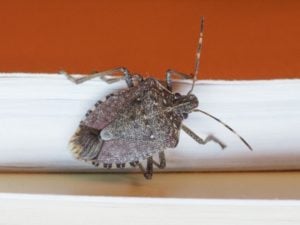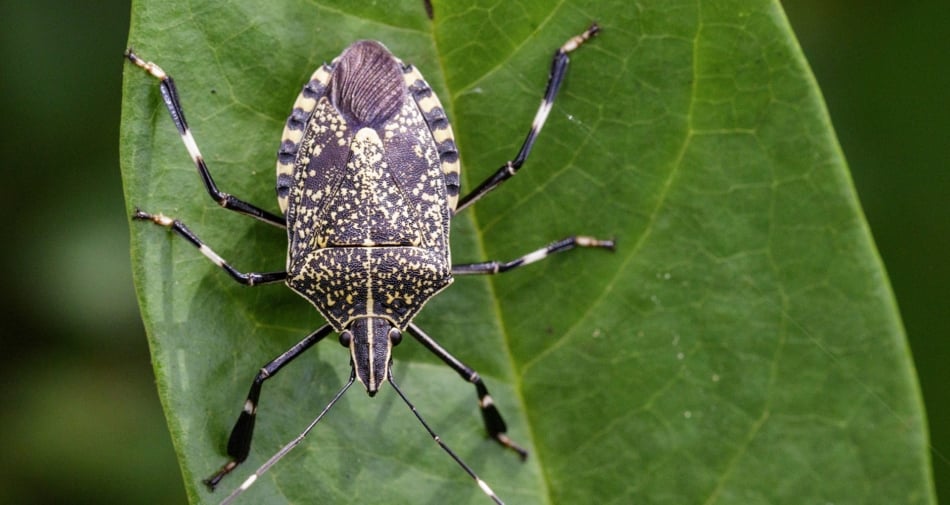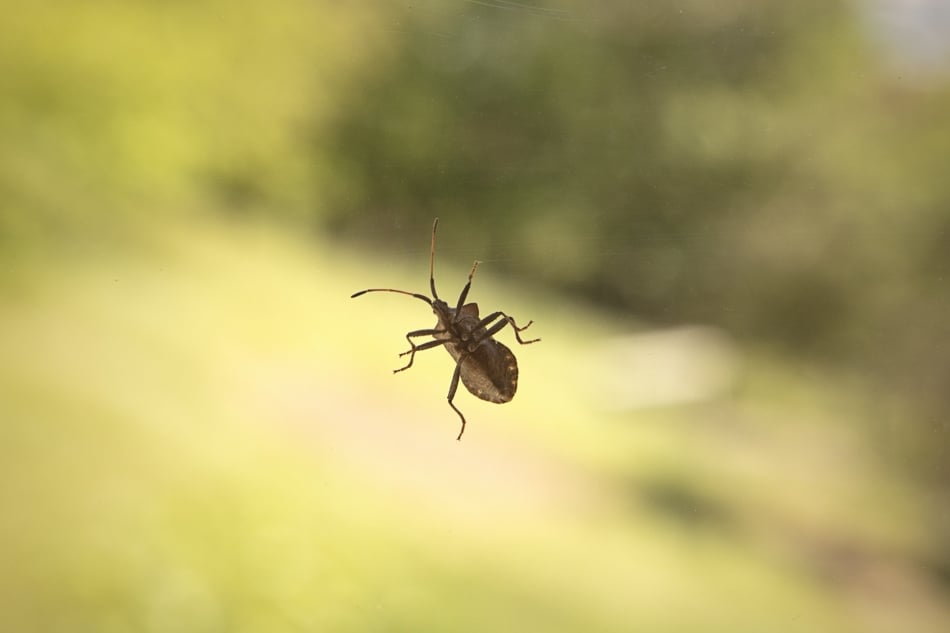How To Get Rid of Stink Bugs
Stinkbugs are an invasive pest that show up unannounced this time of year. Learn what to do about these creepy bugs invading your home or garden!

Has this ever happened to you? You’re gazing out the window when you spot a creepy brown bug that looks like something from a sci-fi action thriller clinging to your screen. If the critter in question has a broad, shield-shaped body with stripes around the edges and on the antennae, long legs, and a comparatively tiny head, you may have a stink bug on your hands.
Brown Marmorated Stink Bug

The brown marmorated stink bug (Eocanthecona furcellata) or simply “stink bug” for short, is an invasive pest that is native to China. It was first discovered in the United States in the late 1990s, in the state of Pennsylvania. This critters have since spread to 40 states, as well as parts of Canada, though they are still most plentiful in the Mid-Atlantic region, including Pennsylvania, New York, New Jersey, Maryland, and Delaware.
Stink bugs range in size from half an inch to an inch in size, but their most notable characteristic is the one that gives them their name: When they are frightened, disturbed, or killed by crushing, they emit a pungent odor that some describe as skunk-like. Some say it smells like the foliage of tomato plants.
These bugs are becoming an increasingly problematic agricultural pest as they inject their sharp, pointy mouths into fruit and other crops, leaving behind rotted areas that make them unviable for sale as fresh produce.
To the average homeowner, though, these bugs are mostly harmless. They do not cause any structural or other damage and, unlike roaches, ants, and other common household pests, stink bugs are solitary creatures and do not travel in colonies. While you may find a group of stinkbugs together in a garden, these are simply individuals drawn to the same food source.
Spring and Fall Pests
Stink bugs emerge in the spring to feed and reproduce, but they have been seen at all times of year, in nearly all regions of the United States. Late July and August are the most common times to see damage to plants. And in the fall, as the weather turns colder, the bugs start invading homes in search of a warm place to spend the winter. They typically gather on warm, west-facing walls and enter buildings via cracks and crevices.
How To Get Rid Of Stink Bugs In Your Home
If you find a stink bug, or a few, in your home, do not panic. They are harmless to humans, structures, and fabrics. Whatever you do, do not crush a stink bug. As its name suggests, a threatened or crushed stinkbug will release an unpleasant, skunky odor. The easiest way to get rid of stink bugs is to vacuum them up. If you have a Shop-Vac or a little-used spare vacuum you keep in a garage, use it to prevent the smell from infiltrating your home. Be sure to replace the bag immediately, or clean out a bagless model with vinegar.
Some people like to catch them and flush them down the toilet. While effective, this method also results in a lot of wasted water if used too frequently.
Keeping Stink Bugs Out
- To keep stink bugs from invading your home in the first place, make sure everything is sealed up well. Fill in cracks around windows, doors, siding, utility pipes, chimneys, and underneath fascia with good quality silicone or silicone-latex caulk. Repair or replace damaged screens on doors and windows.
- Sprinkle food-grade diatomaceous earth both inside and outside, targeting areas where they may be getting in (windows, doorways). It acts as a natural, abrasive barrier to crawling insects and is harmless to humans and pets.
- Stink bugs are repelled by garlic. Crush a few garlic cloves and put in a dish on a windowsill and at entryways.
Getting Them out Of Your Garden
- While stink bugs pose no real threat to homeowners, they can be incredibly destructive pests for farmers and gardeners. They feed on a wide range of tree fruits and seed pods as well as many vegetables including tomatoes, peppers, beans, and sweet corn.
- To keep them from devouring your garden, you can purchase commercial stink bug traps. Planting sunflowers and marigolds will also help by attracting beneficial insects that will eat stink bug eggs and larva.
- Sprinkle food-grade diatomaceous earth beneath growing watermelon, cantaloupe, squash and all fruits and vegetables resting on the ground, as well as on plant leaves.
- Stink bugs also dislike the smell of mint. Consider planting it in your garden, or crushing a few leaves and scattering them around the base of other plants.
- While the above remedies are deterrents, you can also make a solution of mild soapy water with dish soap, and spray directly on the bugs to kill them.
Is It A Stink Bug? Meet The Lookalikes

Squash bugs and Western Conifer Seed Bugs are often confused with stink bugs. Here’s how to tell them apart, via Michigan State University. Additionally, many people report getting “bit’ by stink bugs but this is highly unlikely. True marmorated stink bugs’ mouth aren’t designed for biting. The only food source they’re interested in is plant material and nothing related to mammals.

Jaime McLeod
Jaime McLeod is a longtime journalist who has written for a wide variety of newspapers, magazines, and websites, including MTV.com. She enjoys the outdoors, growing and eating organic food, and is interested in all aspects of natural wellness.






During stink bug season, I keep little stacks of paper towel squares (a full sheet cut in quarters). When I see a stink bug, I wet the paper towel piece under the faucet, and place it over the bug. That contains any stink if it emits it. Then it’s easy to pick up and put in the trash. No smell. If it crawls out in the trash, it should be happy to stay there with the “snacks”.
What about neem oil spray ? it works against them darned Japanese beetles !
Can we stop with the hippy dippy safe-and-sane Racheal Carson approved remedies, what do farmers actually use? You know something with a chemical name the plebeians can’t pronounce and irrationally fear. Something with a chemical name so large you need to abbreviate it, like DDT. Something with warning labels, not “deterrents” that are food safe. Something that you have to dilute while wearing gloves. Something that is banned in Commiefornia but I can buy online anyway. That’s the kinda anti-stink bug poison I’m looking for. I have a serious NEW invasion over 4 acres of profitable crops.
Mark I concur 👍 these bugs are out of control and no predators to eat them
The issue is they punch through the fruit surface and drink the fruit much like a mosquito does a person. So you can’t put down a poison it’d need to be the whole plant poisons them, which would make them inedible to us too. The bugs nomadic rather than seasonally migrating so you dont retain a population to remember to leave you alone.
Baitings really the answer, feed them to the fish after.
Once the soapy water is sprayed on the plant, is it necessary to rinse the plant off? And can I add diatomaceous earth to the mix?
Diatomaceous earth needs to be dry to work
So what commercial poisons kill them in the garden?
I have tried many things on these little buggers since they invaded our area 10 ish years ago. Not much has worked very well till last year I started spraying my yard with cedar spray for earwigs, fleas, ticks, misquotes. Well guess what I now see very few stink bugs, it use to be you could hardly open the door without one coming in.
Oh thanks for sharing Judy! We will give it a try!
What is cedar spray. How do I get it. I have an invasion of earwigs
They are a pain, in both garden and house. What we found works best inside is a 14 oz. veggie can, rinsed clean, then add about a full teaspoon of cheap dish soap, then about 1/2 can fuilled with water. I use a stiff, plastic-coated piece of junk mail to scoot them into the can. They died within 15-30 secs., without stinking. Also works well for the Ladybug invasions. They die 10 – 20 secs. When there’s a good bunch collected, flush away. Other thing helping around doorways is store-bought Lemon-grass spray. And there’s always chickens, but can’t get past the thought of eating eats made by stinkbug-eating chickens.
It’s bad luck to kill ladybugs.
I believe Ed is referring to the uglier invasive & annoying Asian Lady Beetles
those brown ones are just bad luck in themselves…nasty buggers. Don’t kill the true red lady bugs.
Oh my goodness??? n
I live in the Caribbean and stinky bugs are eating the leaves to my black sage trees. Recently I noticed them on my pigeon pea trees this year. I sprayed them with some homemade lemon rind water, but that did not help. I will try the garlic and salt water. Garlic does not grow very well in my neck of the woods, but I will scatter the garlic skins around the plant. So far they have not found my tomato plants. Hope they never do. I have tried catching them to place them in a soapy liquid, they always fly away.
Rice water in a sprayer will knock them down and goop them too much to fly and be plant safe if you dont get it all off. Then you can dump the bug in soap bucket.
I sure would love to know suggestions for getting rid of the new and disgusting Aedes mosquito from Asia. (I live in So CA.) It is literally eating us alive!
Mosquitos easier, ask a local nature authority which dragonflies are native to you and order some. The larvae grow up on pond surfaces like mosqutos do and the adults are insect hunters.
That or grab some fish to keep in the standing water, less effective cause it assumes you have direct access to all water bodies, and that all of them are deep enough to support.
We had stink bugs since I was a kid in the 60s. You mentioned them coming from China in the 90s. Is that a different type? They look very similar except ours were gray.